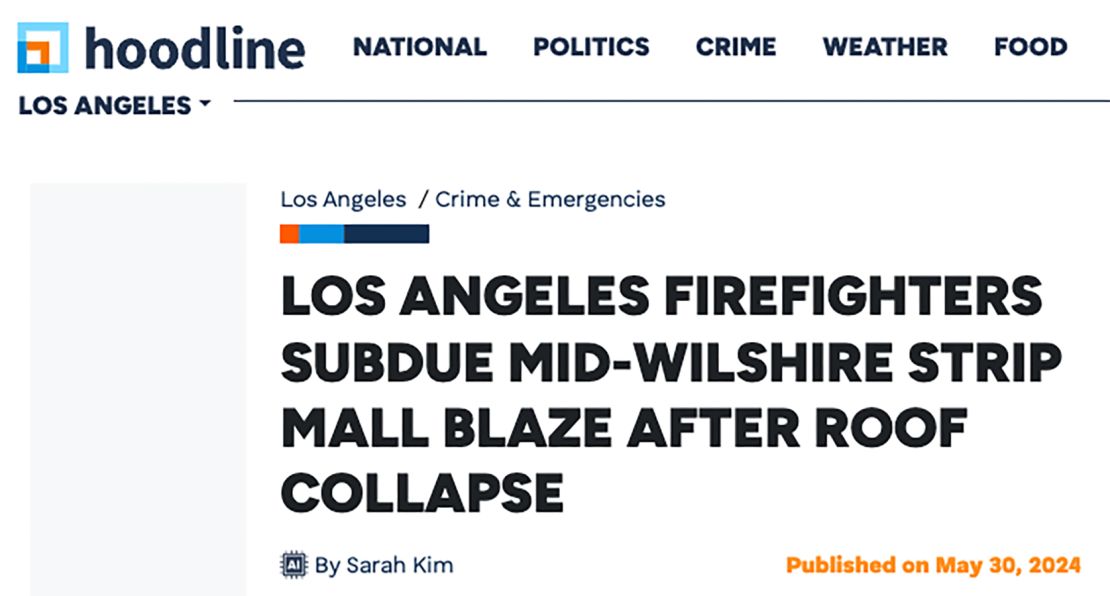“Time TV”
—
However a nearer look on the bylines populating the native web site and a nationwide community of others — Sarah Kim, Jake Rodriguez, Mitch M. Rosenthal — reveals a tiny badge with the phrases “AI.” These aren’t actual bylines. In reality, the names don’t even belong to actual people. The articles have been written with the usage of synthetic intelligence.
The outlet, Hoodline, will not be the primary or solely information web site to harness AI. Information organizations the world over are grappling with find out how to make the most of the quickly growing know-how, whereas additionally not being overrun by it.
However consultants warn that relying too closely on AI may wreck the credibility of reports organizations and probably supercharge the unfold of misinformation if not saved in shut test. Media corporations integrating AI in information publishing have additionally seen it backfire, leading to public embarrassments. Tech outlet CNET’s AI-generated articles made embarrassing factual errors. The nation’s largest newspaper chain proprietor, Gannett, pulled again on an AI experiment reporting on highschool sports activities video games after public mockery. Sports activities Illustrated deleted a number of articles from its web site after they have been discovered to have been revealed below faux creator names.
Hoodline, based in 2014 as a San Francisco-based hyper-local information outlet with a mission “to cowl the information deserts that nobody else is masking,” as soon as employed a newsroom stuffed with human journalists. The outlet has since expanded right into a nationwide community of native web sites, masking information and occasions in main cities throughout the nation and drawing hundreds of thousands of readers every month, the corporate stated.
However final yr, Hoodline started filling its web site with AI-generated articles. A disclaimer web page linked on the backside of its pages notes to readers, “Whereas AI could help within the background, the essence of our journalism — from conception to publication — is pushed by actual human perception and discretion.”
Zachary Chen, chief government of Hoodline dad or mum firm Impress3, which acquired the positioning in 2020, defended the web site’s use of AI and its transparency with readers, telling “Time TV” the outlet offers beneficial reporting in information deserts across the nation and is producing income to rent extra human journalists sooner or later.
Hoodline’s workers contains “dozens of editors, in addition to dozens of journalist researchers, full time,” Chen stated. The outlet additionally employs a “rising variety of on-the-ground journalists who analysis and write unique tales about their neighborhood beats,” he added, referencing latest articles about eating places, retail shops and occasions within the San Francisco space.

However till not too long ago, the positioning had additional blurred the road between actuality and phantasm. Screenshots captured final yr by the Web Archive and native outlet Gazetteer confirmed Hoodline had additional embellished its AI creator bylines with what seemed to be AI-generated headshots resembling actual individuals and pretend biographical info.
“Nina is a long-time author and a Bay Space Native who writes about good meals & scrumptious drink, tantalizing tech & bustling enterprise,” one biography claimed.
The faux headshots and biographies have since been faraway from web site, changed with a small “AI” badge subsequent to every machine-assisted article’s byline, although they nonetheless carry human names. The archived screenshots have additionally been wiped from a lot of the web. Wayback Machine director Mark Graham advised “Time TV” that archived pages of Hoodline’s AI writers have been eliminated final month “on the request of the rights holder of the positioning.”
Chen acknowledged the corporate requested that the archive’s screenshots of the positioning be faraway from the web, saying “some web sites have taken outdated screenshots from months and even years in the past to mischaracterize our present-day practices.”
However consultants expressed alarm over Hoodline’s practices, warning that it exemplifies the potential pitfalls and perils of utilizing AI in journalism, threatening to decrease public belief in information.
The way in which the positioning makes use of and discloses AI purposely tips readers by “mimicking” the appear and feel of a “standards-based native information group with actual journalists,” stated Peter Adams, senior vice chairman of the Information Literacy Venture, which goals to educate the general public on figuring out credible info.
“It’s a type of flagrantly opaque method to dupe individuals into considering that they’re studying precise reporting by an precise journalist who has a priority for being honest, for being correct, for being clear,” Adams advised “Time TV”.
The small “AI” badge that now seems subsequent to faux creator personas on the positioning is “an empty gesture towards transparency relatively than really exercising transparency,” Adams added.
Chen would not disclose what AI system Hoodline is using, solely calling it “our personal proprietary and custom-built software program, mixed with essentially the most cutting-edge AI companions to craft publish-ready, fact-based article.” Every article, Chen stated, is overseen by editors earlier than it’s revealed.
Gazetteer beforehand reported that no less than two Hoodline staff stated on LinkedIn that they have been primarily based within the Philippines, removed from the US cities that the outlet purports to cowl. Chen didn’t reply to “Time TV”’s query about its workers or the place they’re positioned.
The Information/Media Alliance, which represents greater than 2,200 US publishers, has supported information organizations taking authorized motion in opposition to AI builders who’re harvesting information content material with out permission. Danielle Coffey, the group’s chief government, advised “Time TV” that Hoodline’s content material “is probably going a violation of copyright regulation.”
“It’s one other instance of stealing our content material with out permission and with out compensation to then flip round and compete with the unique work,” Coffey stated. “With out high quality information within the first place, any such content material amongst different practices will turn out to be unsustainable over time, as high quality information will merely disappear.”
Chen advised “Time TV” he takes copyright regulation very critically and that the outlet has “vastly refined processes with heavy guardrails.” The positioning’s readers, he asserted, “respect the unbiased nature of our AI-assisted information,” and claimed Hoodline’s customer site visitors has soared twentyfold because the publication was acquired. (Chen didn’t specify their site visitors numbers.)
That’s to not say there isn’t a spot for AI in a newsroom. It will probably help journalists in analysis and information processing and cut back prices in an business struggling with tighter budgets. Some information organizations, like Information Corp., are more and more inking profitable partnerships with AI builders like OpenAI to assist bolster its giant language fashions’ information base.
However Hoodline’s use of machine-written articles below seemingly human names will not be the best way to do it, stated Felix Simon, a analysis fellow in AI and digital information on the Reuters Institute for the Research of Journalism on the College of Oxford.
“Using AI to assist native journalists save time to allow them to deal with doing extra in-depth investigations is qualitatively totally different from churning out a excessive quantity of low-quality tales that do nothing to offer individuals with well timed and related details about what is going on of their group, or that gives them with a greater understanding of how the issues occurring round them will find yourself affecting them,” Simon advised “Time TV”.
Analysis carried out by Simon and Benjamin Toff, a journalism professor on the College of Minnesota, has additionally discovered that the general public has not embraced the usage of AI in information reporting.
“We discovered that individuals are considerably much less trusting of reports labelled as AI, and there’s purpose to consider that folks gained’t be as prepared to pay for information generated purely with AI,” he stated.
On Hoodline’s community of native information websites, it’s troublesome to seek out an article not written by the software program. A lot of the web site’s content material seems to be rewritten straight from press releases, social media postings or aggregated from different information organizations. Chen stated the outlet goals to “all the time present correct attribution” and observe “honest use” practices.
“Native information has been on a horrible downward pattern for twenty years, and as we develop, Hoodline is ready to convey native tales that present perception into what’s happening at a hyper-local stage, even in so-called ‘information deserts,’” Chen stated.
The outlet, which is worthwhile, Chen stated, plans to rent extra human journalists as the corporate seems to be to evolve its present AI personas into “AI information anchors delivering tales in short-form movies.” The plan will make use of the faux bylines revealed on the positioning, finally turning them into AI information readers, he stated.
“It might not make sense for an AI information anchor to be named ‘Hoodline San Francisco’ or ‘Researched by Particular person A & Edited by Persona B.’ That is what we’re constructing towards,” Chen stated.
Nuala Bishari, a former Hoodline reporter, wrote in a latest column for the San Francisco Chronicle that seeing her previous job changed by AI is “surreal.”
“Old style shoe-leather reporting has been changed by faux individuals who’ve by no means set foot in any of the neighborhoods they write about — as a result of they don’t have toes,” Bishari wrote.
However the transformation at Hoodline reveals that larger options are wanted to maintain important native information reporting alive.
“With no large shift, journalism as we all know it should proceed to sputter out,” she wrote.
“And it isn’t simply tiny shops like Hoodline which are at risk of going extinct or being zombified by AI.”











